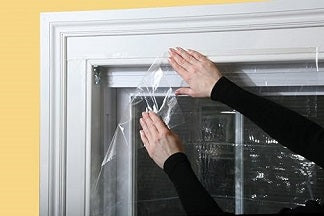
How to Choose the Best Window Insulating Plastic
Plastic window insulation is a practical and cost-effective alternative to replacing windows. This is particularly true in situations where budget constraints or temporary solutions (think renters) are a consideration. While window replacement is the most optimum solution, it involves a significant upfront investment in materials and labor. Plastic insulation, on the other hand is a more accessible and affordable option.
Why Insulate Windows with PlasticInsulating windows with plastic film / sheets is a quick fix for reducing drafts and improving energy efficiency. You can improve home comfort without the need for major construction work.
Plastic window insulation can be particularly useful for older or single-pane windows that lack efficiency of modern windows. It's a flexible and cost-effective approach, allowing residents to address specific windows or seasonal needs. Moreover, you can easily remove plastic insulation when not needed. And depending on the type of plastic used, you can reuse the sheets the following season.
Understanding Window Insulating Plastic ThicknessThe window films in these kits commonly range in thickness around 1 to 2 mils. Thinner films are prevalent in these kits due to their intended lightweight, flexible, and easily manageable nature during installation. The property that gives it flexibility also results in these films not being as sturdy and hence more prone to tearing. So while effective at blocking drafts, the plastic in shrink and seal kits is not as good an insulator as thicker materials.
Clear vinyl sheets can range from 6 to 8 mils or more, therefore provide enhanced insulation for your windows. Evaluate the climate of your region to determine the appropriate thickness for optimal insulation. Thicker vinyl sheets may be more suitable for extreme temperatures, providing enhanced protection against heat or cold. They also offer a more durable option that can last many seasons.
Considering Clarity for Window InsulationThe window plastic film in shrink and seal kits typically consists of a thin plastic material known as polyethylene. Polyethylene is a versatile plastic known for its flexibility and its ability to shrink when exposed to heat. Installing it involves placing the film on the window, followed by the application of heat, often from a hairdryer. This causes the film to shrink, creating a tight seal over the window.
This method effectively reduces drafts, enhances insulation, and improves energy efficiency, especially during colder months. However, it's worth noting that the clarity of polyethylene may not match that of some other materials. Additionally, it is generally considered a temporary solution suitable for seasonal insulation needs.
The clarity of PVC vinyl sheets can vary, ranging from slightly foggy to super clear. Factors affecting clarity of the plastic include
- thickness of the sheet
- the presence of any additives such as plastic softeners,
- the overall quality of the manufacturing process.
In general, higher-quality PVC vinyl sheets tend to offer better clarity. Clear or super clear PVC sheets allow for optimal visibility, ensuring that natural light can pass through without distortion.
Condensation On Window InsulationThe window film in shrink and seal kits can be more prone to condensation compared to certain other materials. This is because Polyethylene, while effective for insulation does not breathe or allow moisture to escape easily. When warm, moist air comes into contact with the cold surface of the window, condensation can occur. This can potentially lead to issues such as reduced visibility and moisture-related problems if not properly managed.
PVC vinyl sheets, due to their composition, are generally less susceptible to condensation. PVC is a more rigid and less porous material, which can contribute to better moisture resistance.
However, where there is a significant temperature difference between the indoor and outdoor environments condensation can still exist. Properly securing the vinyl sheets to the window frame will create a more airtight barrier. This will minimize the the likelihood of warm air reaching the cold surface of the window.
Selecting the right window insulating plastic involves a thoughtful consideration of both thickness, clarity and and condensation resistance. Whether you opt for the budget-friendly shrink & seal kits or invest in the enhanced insulation provided by thicker PVC vinyl sheets, your choice can significantly impact your home's energy efficiency. Moreover, assessing condensation resistance is crucial for maintaining visibility and preventing potential moisture-related issues. As you make choices, factor in your aesthetic preferences and the importance of natural light.
No comments






0 comments